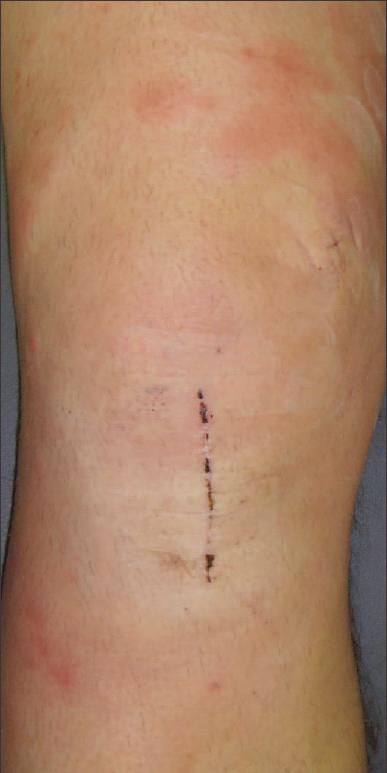Rash After Anterior Cruciate Ligament Reconstruction
A healthy 35-year-old man sustained a complete anterior cruciate ligament (ACL) tear of his right knee while playing soccer and underwent an uncomplicated ACL reconstruction with a bone-patella tendon-bone autograft. During his first postoperative week, a nonpruritic rash

A healthy 35-year-old man sustained a complete anterior cruciate ligament (ACL) tear of his right knee while playing soccer and underwent an uncomplicated ACL reconstruction with a bone-patella tendon-bone autograft. During his first postoperative week, a nonpruritic rash
developed around the surgical incision (photograph). He was concerned about infection.
The patient had minimal pain, moderate soft tissue swelling, and no postoperative fever. On physical examination, there was a mild effusion, mild diffuse tenderness, and painless range of motion (0° to 85°). The skin lesions were erythematous, patchy, and nonelevated. The rash was well localized and did not extend above midthigh or below midcalf. There was no lymphadenopathy or drainage from the incision. The patient's neurovascular status was normal. Plain radiographs revealed no abnormalities. No laboratory values were obtained.
What is your diagnosis?
(Find the answer on the next page)

The photograph at left shows the patient's right knee 7 days after the ACL reconstruction, and the photograph below is a close-up showing right knee lesions surrounding the surgical incision. The patient had a mild case of frost nip (chilblain, or pernio) that resulted from the use of a cooling device around the knee after surgery to control inflammation and reduce pain.
A thorough clinical history is essential to discern this diagnosis from other possibilities, such as infection or allergic reaction. Frost nip typically occurs after an unprotected area of skin experiences cold at a temperature of 0ºC to 15ºC (32ºF to 60ºF). (Frostbite requires skin exposure at a temperature lower than 0°C [32°F].) Typically, the lesions characteristic of frost nip are localized to the area of cold exposure. They appear erythematous or cyanotic and may be slightly raised. In severe cases, blistering and ulceration m

ay occur.
Symptomatic treatment for patients with frost nip is appropriate. Treatment typically includes observation, protection of the skin from further cold exposure and, if needed for pain relief, a mild analgesic. The patient described here was treated with observation and skin protection. The condition resolved without complications.
Typically, there are no long-term sequelae associated with frost nip. This condition is prevented by ensuring adequate skin protection before applying ice or a cooling device.
This case was submitted by Michael J. DeFranco, MD, and Bernard R.Bach Jr, MD, of Midwest Orthopaedics at Rush University Medical Center in Chicago.
Send us your slides
We invite you to submit slides of patients with musculoskeletal disorders. Clinical slides are preferred, but roentgenographic slides or prints are acceptable.We especially welcome cases of common clinical problems with an unusual, confusing, or misleading initial presentation.We offer an honorarium for each slide or pair of slides ("before" and "after" views are welcome) or prints accepted for publication.
Please provide a 1-paragraph description of the findings shown, as well as relevant history and physical examination findings; then indicate diagnoses you considered, your final diagnosis, your treatment, and the outcome. All slides and films will be returned after evaluation or publication.
Submit your case to Photo Editor, The Journal of Musculoskeletal Medicine, 330 Boston Post Road, Box 4027, Darien, CT 06820-4027.